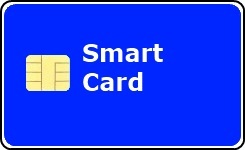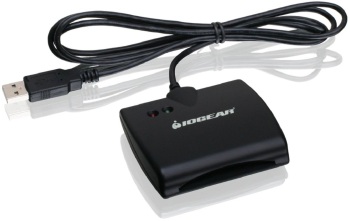
A smart card is a security card that is the size of a credit card. Smart cards are typically used to make prepaid telephone calls, pay for subway, train, or bus transportation, make electronic payments, get access to a restricted area, computer or network.
Smart cards are more popular in Europe than in the United States. In the United States Magnetic stripe technology is in wider use. However a smart card contains a small amount of semi-conductor memory that can store more information than a magnetic stripe card.
Some smart cards contain an embedded microprocessor which can be programed with applications. Some smart cards have electrical contacts, the microprocessor is under a gold contact pad on one side of the card. Many cards are contactless and use radio-frequency to operate.
Some smart cards are designed to be inserted into a slot and read by a card reader. Many cards require a password or PIN to activate. Other smart cards can communicate by being in the proximity of a special reader. Proximity smart cards are sometimes in a different form than card shaped.

Smart cards can be used with a USB card
reader attached to a PC to authenticate a user.
Smart cards are difficult to counterfeit because the cards contents are encrypted, but proximity smart cards which can be read at a distance, can be hacked by person walking nearby even if you don't have the card out of your wallet or purse.
More Windows Administration Information:
• Root Kit - The Hackers Backdoor to Your Computer
• Has Malware Turned Off Your PC's User Account Control?
• Computer Technician's Guide to Biometric Security Devices
• Easiest Ways to Beat Ransomware
• Computer Architecture, Main Memory, and the CISSP Exam
• PC Chassis Intrusion Detection
• Remove Stubborn Malware Infection With McAfee Labs Stinger
• Set Windows Defender to Scan Core Operating System Files
• DriveLock Hard Drive Protection
• Computer Architecture, Hardware domain of the CISSP Exam

